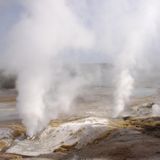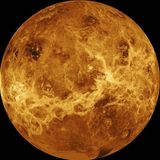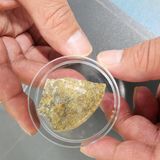RECENT ARTICLES

NASA’s Psyche mission will explore a metal-rich asteroid. Here's why.
This strange asteroid could be the exposed heart of a failed planet—or something even more mysterious. NASA is about to find out. Hiding within the asteroid belt exists a world suffused with metal, where the surface may be covered in cliffs and craters of iron alloys. Glimpsed only as a bright speck in telescope images, no one knows exactly what the metal asteroid, named Psyche, looks like. It could simply be a lump of rock and metal—but it could also be decorated with an array of otherworldly aspects, from frozen flows of sickly yellow lava to upright tendrils of solidified iron, like...…This strange asteroid could be the exposed heart of a failed planet—or something even more mysterious. NASA is about to find out. Hiding within the asteroid belt exists a world suffused with metal, where the surface may be covered in cliffs and craters of iron alloys. Glimpsed only as a bright speck in telescope images, no one knows exactly what the metal asteroid, named Psyche, looks like. It could simply be a lump of rock and metal—but it could also be decorated with an array of otherworldly aspects, from frozen flows of sickly yellow lava to upright tendrils of solidified iron, like...WW…

A chunk of Yellowstone the size of Chicago has been 'pulsing.' Why?
Please be respectful of copyright. Unauthorized use is prohibited.In northwestern Wyoming, in the center of Yellowstone National Park, a bubbling caldera is the . The park encompassing the caldera is filled with geologic wonderlands of sprouting geysers and effervescing pools, all ultimately driven by magma and superheated fluids churning in the rock below the surface.One of these areas, to the northwest of the caldera, contains more than 500 hydrothermal features. These tempestuous geysers and pools often change from day to day, but a much larger transformation has been taking place as...…Please be respectful of copyright. Unauthorized use is prohibited.In northwestern Wyoming, in the center of Yellowstone National Park, a bubbling caldera is the . The park encompassing the caldera is filled with geologic wonderlands of sprouting geysers and effervescing pools, all ultimately driven by magma and superheated fluids churning in the rock below the surface.One of these areas, to the northwest of the caldera, contains more than 500 hydrothermal features. These tempestuous geysers and pools often change from day to day, but a much larger transformation has been taking place as...WW…

Does lightning strike on Venus? Mysterious flash may help solve puzzle.
A flicker of light spotted by a spacecraft orbiting the planet could bring a 40-year quest to an end.On March 1, 2020, humanity’s only spacecraft orbiting Venus—Japan’s Akatsuki—saw a mysterious flash in the planet’s alien skies. The flicker could provide crucial evidence in a 40-year quest to answer a perplexing planetary puzzle: Is there lightning on this cloud-shrouded world?Lightning is found all over the solar system. Spacecraft have in the clouds of Jupiter, Saturn, and Uranus. Cloaked in thick clouds, “we expect there to be lightning on Venus” as well, says , a planetary geologist at...…A flicker of light spotted by a spacecraft orbiting the planet could bring a 40-year quest to an end.On March 1, 2020, humanity’s only spacecraft orbiting Venus—Japan’s Akatsuki—saw a mysterious flash in the planet’s alien skies. The flicker could provide crucial evidence in a 40-year quest to answer a perplexing planetary puzzle: Is there lightning on this cloud-shrouded world?Lightning is found all over the solar system. Spacecraft have in the clouds of Jupiter, Saturn, and Uranus. Cloaked in thick clouds, “we expect there to be lightning on Venus” as well, says , a planetary geologist at...WW…

Crumbly Mars Rock, Not Hardware Flaws, Scuttled Perseverance’s First Sample Attempt
For the Perseverance rover team at NASA’s Jet Propulsion Laboratory (JPL), the early predawn hours of August 6 were like the night before Christmas. Hours earlier, the scientists had ordered the rover to drill into a rock within Mars’s Jezero Crater to extract and store the mission’s —one of up to 43 specimens that will one day be delivered to Earth and .Around 2 A.M., as they began reviewing fresh data beamed back from Mars by the rover, everything looked to have proceeded perfectly: the sample appeared to have been acquired and placed in one of the rover’s 43 storage tubes. But a nasty...…For the Perseverance rover team at NASA’s Jet Propulsion Laboratory (JPL), the early predawn hours of August 6 were like the night before Christmas. Hours earlier, the scientists had ordered the rover to drill into a rock within Mars’s Jezero Crater to extract and store the mission’s —one of up to 43 specimens that will one day be delivered to Earth and .Around 2 A.M., as they began reviewing fresh data beamed back from Mars by the rover, everything looked to have proceeded perfectly: the sample appeared to have been acquired and placed in one of the rover’s 43 storage tubes. But a nasty...WW…

NASA Picks Two Missions to Explore Venus, the First in Decades
On the morning of June 2, rumors began swirling that NASA was about to announce its latest choices for interplanetary missions, selecting the long-awaited winners of the agency’s competition for new spacecraft in its relatively low-priced Discovery exploration program. Four contending teams anxiously awaited the results: One wished to send a mission to Jupiter’s hypervolcanic moon Io. Another desired a visit to Triton, a cryovolcanic moon of Neptune. And the other two wanted to go to Venus, a destination the space agency had neglected for decades.A press conference led by NASA administrator...…On the morning of June 2, rumors began swirling that NASA was about to announce its latest choices for interplanetary missions, selecting the long-awaited winners of the agency’s competition for new spacecraft in its relatively low-priced Discovery exploration program. Four contending teams anxiously awaited the results: One wished to send a mission to Jupiter’s hypervolcanic moon Io. Another desired a visit to Triton, a cryovolcanic moon of Neptune. And the other two wanted to go to Venus, a destination the space agency had neglected for decades.A press conference led by NASA administrator...WW…

Why the volcano erupting in the Caribbean has such a deadly reputation
Please be respectful of copyright. Unauthorized use is prohibited.Since December 2020, a strange and gloopy mass of lava has been oozing from the top of La Soufrière, a volcano on the northern side of the Caribbean island of St. Vincent. This eruption posed no real threat to the 110,000 or so people living on the island, but things took a turn for the worse at the end of March, when the volcano began shaking in a way that suggested something more violent was coming.Sure enough, at 8:41 a.m. local time today, the first of several major explosions rocked the mountain, kicking off a more...…Please be respectful of copyright. Unauthorized use is prohibited.Since December 2020, a strange and gloopy mass of lava has been oozing from the top of La Soufrière, a volcano on the northern side of the Caribbean island of St. Vincent. This eruption posed no real threat to the 110,000 or so people living on the island, but things took a turn for the worse at the end of March, when the volcano began shaking in a way that suggested something more violent was coming.Sure enough, at 8:41 a.m. local time today, the first of several major explosions rocked the mountain, kicking off a more...WW…

DNA study of 6,200-year-old massacre victims raises more questions than answers
Archaeologists assumed an extended family died in violence thouands of years ago, but the largest genetic study of a mass killing to date suggests otherwise.Around 6,200 years ago, a group of at least 41 men, women, and children were brutally murdered before being dumped in a mass grave in what is now eastern Croatia. Initially, the archaeologists who uncovered the grave in 2007 wondered if the victims were an entire inter-related community targeted for execution. But a new analysis reported in the journal —including what is the largest genetic study of an ancient massacre to date—reveals...…Archaeologists assumed an extended family died in violence thouands of years ago, but the largest genetic study of a mass killing to date suggests otherwise.Around 6,200 years ago, a group of at least 41 men, women, and children were brutally murdered before being dumped in a mass grave in what is now eastern Croatia. Initially, the archaeologists who uncovered the grave in 2007 wondered if the victims were an entire inter-related community targeted for execution. But a new analysis reported in the journal —including what is the largest genetic study of an ancient massacre to date—reveals...WW…

Giant Galaxies from the Universe’s Childhood Challenge Cosmic Origin Stories
Recently an international team of astronomers traveled back in time to when our universe was just 1.8 billion years old. They did not go directly, of course, but settled for the next best thing: gathering 17 hours’ worth of starlight from a single small patch of the distant cosmos with the Large Binocular Telescope Observatory atop Mount Graham in southeastern Arizona. Such clock-rewinding virtual voyages are routine in astronomy—light’s finite speed ensures that the deeper into space you see, the further back in time you gaze. And many observatories around the globe can gather faint...…Recently an international team of astronomers traveled back in time to when our universe was just 1.8 billion years old. They did not go directly, of course, but settled for the next best thing: gathering 17 hours’ worth of starlight from a single small patch of the distant cosmos with the Large Binocular Telescope Observatory atop Mount Graham in southeastern Arizona. Such clock-rewinding virtual voyages are routine in astronomy—light’s finite speed ensures that the deeper into space you see, the further back in time you gaze. And many observatories around the globe can gather faint...WW…

Mysterious magnetic pulses discovered on Mars
Please be respectful of copyright. Unauthorized use is prohibited.At midnight on Mars, the red planet’s magnetic field sometimes starts to pulsate in ways that have never before been observed. The cause is currently unknown.That’s just one of the stunning there, the InSight lander. Since , this spacecraft has been gathering intel to help scientists better understand our neighboring planet’s innards and evolution, such as taking the temperature of its upper crust, recording the , and measuring the strength and direction of the planet’s magnetic field.As revealed during a handful of...…Please be respectful of copyright. Unauthorized use is prohibited.At midnight on Mars, the red planet’s magnetic field sometimes starts to pulsate in ways that have never before been observed. The cause is currently unknown.That’s just one of the stunning there, the InSight lander. Since , this spacecraft has been gathering intel to help scientists better understand our neighboring planet’s innards and evolution, such as taking the temperature of its upper crust, recording the , and measuring the strength and direction of the planet’s magnetic field.As revealed during a handful of...WW…

Bizarre life-forms found thriving in ancient rocks beneath the seafloor
Please be respectful of copyright. Unauthorized use is prohibited.In 2013, scientists were stunned to find microbes thriving deep inside volcanic rocks beneath the seafloor off the Pacific Northwest, buried under more than 870 feet of sediment. The rocks were on the flank of the volcanic rift where they were born, and they were still young and hot enough to drive intense chemical reactions with the seawater, from which the microbes derived their energy.Now, however, another team of researchers have discovered living cells inside exceedingly old, cold oceanic crust in the middle of the South...…Please be respectful of copyright. Unauthorized use is prohibited.In 2013, scientists were stunned to find microbes thriving deep inside volcanic rocks beneath the seafloor off the Pacific Northwest, buried under more than 870 feet of sediment. The rocks were on the flank of the volcanic rift where they were born, and they were still young and hot enough to drive intense chemical reactions with the seawater, from which the microbes derived their energy.Now, however, another team of researchers have discovered living cells inside exceedingly old, cold oceanic crust in the middle of the South...WW…